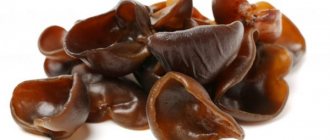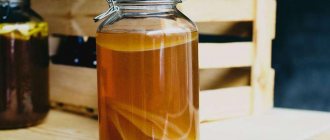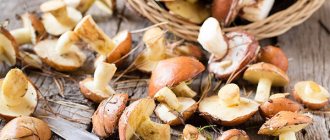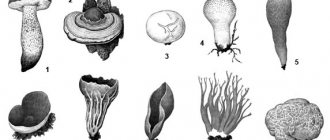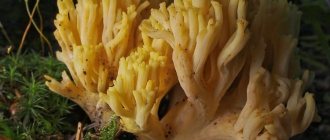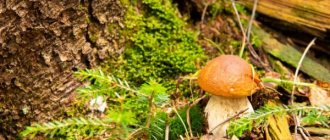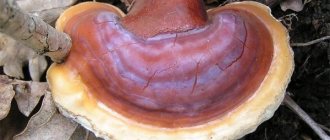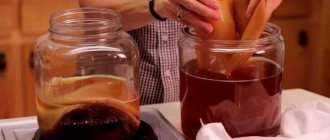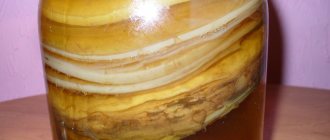Kombucha (kombucha), on the basis of which a deliciously healthy drink is prepared, resembles a yellow-brown jellyfish with a dense upper part, a loose base and thin long threads instead of tentacles. In honor of the marine inhabitant, it received its official name - medusomyces gisevii (medusomycete).
The unusual organism includes yeast fungi and acetic acid bacteria. Together they turn regular tea into a carbonated infusion with a sweet and sour taste, slightly reminiscent of kvass. The resulting drink contains many organic acids, vitamins, enzymes, lipids and sugars, has a beneficial effect on health and prolongs life. It is no coincidence that in Ancient China it was called the elixir of immortality. Now we can prepare kombucha at home and enjoy a refreshing, tasty and healing potion every day.
History of Kombucha Kombucha
Kombucha—we’ll stick with that name—appeared in East Asia and came to Germany via Russia at the beginning of the 20th century. It is believed that kombucha was brought to Russia by soldiers returning from the Russo-Japanese War, and it was initially called “Japanese” or “Manchurian”.
The scientific name of kombucha is medusomyces Gisevi. It first appeared in Russia in Transbaikalia back in the last century. However, Tibet is most often cited as the real homeland of the medusomycete.
Kombucha is one of the oldest organisms used by humans. It may have been grown as far back as Ancient Greece, with the first documented mention of it dating back to 220 BC (Manchuria), but the scientific history of kombucha is much shorter. The first scientific description was made in 1913 by the German mycologist Lindau. Because of its resemblance to a jellyfish, the organism floating on the surface of the liquid was called a medusomycete. Of course, it has nothing in common with a jellyfish. Moreover, it is not a mushroom at all, but a symbiosis of acetic acid bacteria and several types of yeast. In Russia, Ieduzomycete has been studied since the end of the 19th century, and both the composition of the fungus and the healing properties of its infusion were studied, but in the last half century, interest in this subject has noticeably declined. Kombucha is now experiencing another period of close attention from researchers around the world. Employees of the Institute of Theoretical and Experimental Biophysics of the Russian Academy of Sciences summarized the data accumulated by world science during this time and outlined areas of study of medusomycetes that are the most promising from practical and scientific points of view.
The history of the origin of kombucha is still a mystery. The official version of scientists who researched the history of kombucha is as follows: its homeland is Ceylon, it was from there that the culture spread to India, then to China, where the mushroom was considered as a sure way to prolong life; then Manchuria and Eastern Siberia.
The mushroom appeared in our area at the beginning of the 19th century. It was brought as a trophy by participants in the Russo-Japanese War (at least, this is the main version of its appearance in Russia), and already from our country at the beginning of the 20th century it spread throughout Europe. In Russia, first of all, it came to the Volga region, then to Belarus, the Baltic countries, Ukraine and Transcaucasia. Professor S. Bazarevsky published a report in 1915 that the Latvian population of Livonia and Courland used a folk remedy called abrinumsenep, which translated means “miracle mushroom.” The Latvian population attributed this mushroom with miraculous healing powers against many diseases. Some people claimed that the mushroom helped with headaches, but others claimed that the mushroom was good for all diseases.
An undoubted fact is the use of kombucha to produce vinegar at home. And not only at home - in England, France and Prussia, vinegar was made using the so-called Orleans method in open wooden containers; mushroom films reached a weight of 100 kg, and sometimes more. In the second half of the 19th century, this mushroom became quite widespread throughout Russia, and even then our ancestors highly appreciated both its unusual taste and its beneficial health properties.
Kombucha was first cultivated in Eastern countries. In Japan, geisha drank it to maintain a slim figure, used acetic acid to remove warts and brown spots on the face and body, rinsed hair after washing for silkiness and shine, as well as to strengthen hair and get rid of gray hair. In India, this vinegar was used to strengthen paints on fabrics, prepare a thirst-quenching drink, and wash babies with problem skin. In Indonesia it was used for various poisonings. The Vikings also used this liquid to strengthen their strength before battles, and Roman legionaries used a drink called “posca” to quench their thirst on long campaigns.
Residents of the Far East successfully use kombucha for medicinal purposes. This plant has many names - tea kvass, sea kvass, Japanese mushroom, Japanese uterus.
By 1940, kombucha was already in almost every home. Unfortunately, during the Great Patriotic War, the mushroom practically disappeared from our country. This is explained by the fact that at that time there was famine in the country and food, especially sugar, was difficult to obtain. And it is impossible to prepare mushroom infusion without sugar. In the 50s, kombucha became a favorite drink in Italy. However, it was soon rejected because a rumor was started about an alleged connection between taking mushroom infusion and the occurrence of cancer. However, this rumor was quickly refuted, and currently in many pharmacies in Europe, kombucha is freely sold and is popular.
Tea kvass was known in Transbaikalia back in the 19th century as a remedy for certain diseases, especially among the elderly. At the end of the 19th century, it was found that drinking tea kvass significantly improves the well-being of elderly people suffering from arteriosclerosis and is useful for a number of intestinal diseases (for example, constipation).
In the 80s of the 20th century, kombucha was very common in Russia. Unlike many pharmaceuticals that have unpleasant side effects, the active substances in kombucha direct their effects throughout the entire body system; Thanks to its favorable metabolic properties, it can restore normal conditions in cell membranes without any side effects and thus promote good health.
Zooglea is the name given to a living organism formed by symbiosis, that is, the coexistence of two organisms: a yeast fungus with an acetic acid bacterium. Zoogleys include kombucha, kefir mushroom and Japanese rice.
Kombucha recipe
The taste of the drink directly depends on what solution you use. The classic option is to brew 4 tablespoons of loose leaf tea per standard volume. This amount will require about a glass of sugar. You can experiment with green tea, compote, juice, rose hips, and herbal infusions.
Avoid chamomile, sage and other herbs with a high content of essential oils, because they change the structure of the drink when fermented. Instead of sugar, try jam, preserves or honey. When replacing the liquid, leave a little of the old drink so that the process is more active.
Photo: kacrb.ru
Beneficial properties of kombucha
The widespread and constant use of kombucha as a refreshing drink led to the fact that scientists became interested in it, and in the twenties of the last century, scientific works were published on the topic of its beneficial properties.
The list of medicinal properties of kombucha is impressive. It has been proven that tea kvass has antibacterial and antimicrobial effects, helps cure various diseases of the liver and gall bladder, slows down and alleviates the course of tuberculosis, has an antitoxic effect on the body, normalizes blood pressure and gives good results in the treatment of various diseases of the gastrointestinal tract, actively restoring the microflora stomach after taking antibiotics and other chemotherapy drugs.
In addition to its use as a refreshing drink, almost every article can read about its use as a medicine. Reports both past and present speak of a variety of illnesses that Kombucha infusions are used against. The palette of its application is wide; from harmless ailments to the most serious illnesses.
The undeservedly forgotten kombucha will help anyone create a small “factory” of soft drinks at home, producing tasty and, importantly, healthy products that can quench thirst in the summer heat.
Kombucha is an amazing example of the coexistence of two different microorganisms working very well: yeast fungi ferment sugar, forming ethyl alcohol, while bacteria convert alcohol into acetic acid, and sucrose (sugar) into gluconic acid. Along the way, during the life of kombucha microorganisms, other substances beneficial to human health are formed: citric, oxalic and pyruvic acids, enzymes, caffeine, vitamins C, B1, P and even some antibiotics. So the infusion of kombucha acts extremely beneficially, as a powerful biostimulant.
The massive body of the mushroom has the shape of a disk, resembling felt in appearance. The upper part of the colony is shiny, dense, the mushroom is smooth on top, and the lower part acts as a growth zone and has the appearance of numerous hanging threads; below there is a looser colony of yeast fungi and acetic acid bacteria. This is where amazing transformations of ordinary sugar solution and tea leaves into a complex of healing substances useful for the human body take place.
Gluconic, lactic, acetic, malic acids, various enzymes, vitamins C and PP - this is not a complete list of substances that are synthesized in this living laboratory.
In a fresh drink, the process of sugar processing begins with yeast, fermenting it to ethyl alcohol and carbon dioxide. Next, bacteria oxidize the resulting alcohol to acetic acid. As it accumulates, it stops the yeast from working. As a result, a specific drink is formed from sweet tea.
Recommendations for diseases
Kombucha has long been known for its medicinal properties. This drink can and should be drunk by adults and children. For the latter, it plays a particularly important role in the process of healing from illnesses.
- According to mothers, kvass works great against any inflammatory processes, in particular it is effective as a folk remedy for chronic tonsillitis, sore throats, and colds in children. The solution must be slightly warmed, diluted with the same amount of warm boiled water, and gargle with it every hour.
- To heal the mucous membrane of the stomach and intestines, drink kvass for a week. Before drinking, add 1 teaspoon of honey to the glass. If you ate more than the norm at night, drink half a glass of drink before going to bed.
- An eight-day infusion will relieve stagnation in the large intestine. When treating diarrhea, to normalize the bowel movement process, you can drink 100 g of kvass before meals.
- It has long been proven that the infusion perfectly helps to quickly heal burns and wounds on the skin. Take a piece of mushroom and place it on the affected areas, wait until the substance dries, and apply the next layer on top. The procedure can be carried out at least 7 times a day. The duration depends on the complexity of the injury.
- For diabetes mellitus, the product increases the tone of the body and helps fight the disease. It is enough to drink half a glass every three hours.
It is not advisable to prepare a composition from green tea. It contains a large amount of caffeine, which has a destructive effect on the stomach and intestines. Before using mushroom kvass as an auxiliary folk remedy, it is advisable to consult with your doctor. During pregnancy, refrain from drinking kvass.
How to grow kombucha and make a drink from it
How to prepare a drink from kombucha correctly? Medusomycete looks like a thick layered film of yellowish-brown color floating on the surface of a nutrient liquid - an infusion of sweet black tea. The sugars in the liquid can be different (glucose, sucrose, fructose), the type of tea also does not matter, but the strength is important. The usual concentration of tea is from 0.5 to 1.5%, and its excess inhibits the growth of kombucha.
Researchers noticed that the medusomycete practically does not consume the components of the tea infusion (aromatic, tannin and other substances), but is extremely sensitive to its absence. For example, without tea, it does not synthesize ascorbic acid, which is necessary for the life of kombucha.
But, if the medusomycete is satisfied with the conditions created for it, then on the seventh to tenth day of growth it begins to produce a pleasant-tasting sourish carbonated drink (tea kvass). Gas bubbles and acetic acid are provided jointly by yeast and acetic acid bacteria. The specific aroma of the drink is produced by tea and some types of yeast.
Tea kvass is prepared at home. Since the mushroom is constantly growing, you can start with a small piece of kombucha membrane. You can get kombucha if someone you know has a jar of this healthy drink. The bottom layer is separated from the mother mushroom and placed in a three-liter jar, into which cooled, not very strong sweet tea is poured (5-6 teaspoons of sugar per 1 liter). The jar is placed in a warm place.
For the first three days, the mushroom lies sluggishly at the bottom of the jar, and then floats up, and after a week the first portion of the infusion is ready. The emergence of the mushroom begins due to the formation of its metabolic product - carbon dioxide, and the infusion itself becomes carbonated.
At an advanced age, the mushroom reaches a thickness of several centimeters and allows you to drink the infusion daily, unless, of course, you forget to replenish the loss of liquid with a new portion of cold sweet tea. If you pour the kombucha infusion into an empty container, then after one or two weeks a thin translucent layer will form on the surface of the liquid - a colony of microorganisms, which over time will also turn into an adult mushroom.
If you completely forget about kombucha, then all the liquid may evaporate. But the mushroom will come to life as soon as it is poured with sweet water or tea.
It is better to keep the mushroom away from the window, as cold and direct light inhibit its development. The jar of kombucha is not sealed hermetically; it is simply covered with a clean napkin to prevent dust from entering. You must add boiled water with sugar already dissolved in it: raw water contains a lot of soluble calcium salts (water hardness salts), which form calcium gluconate with gluconic acid, which precipitates. You can’t even sprinkle sugar on the mushroom - it causes burns on its body in the form of brown spots. Too strong tea also depresses him.
To the boiled water where the fungus develops, you need to add an infusion of regular tea (until the water is slightly colored) and sugar (at the rate of two tablespoons per three liters of liquid) and leave it to infuse in a glass jar. Kombucha will be ready for consumption after 5-10 days of infusion at a temperature of 25 degrees.
Periodically, the mushroom should be washed in clean water.
The mushroom produces a healthy drink only if certain conditions for its preparation are met.
It is better to have two jars: in one the mushroom will live, and in the other you will pour the finished drink. A jar of the finished drink can be stored in the refrigerator for quite a long time. The optimal temperature for the mushroom is 25°C. Temperatures below 17°C are harmful, as it reduces the activity of the fungus and blue-green algae can develop in it. The mushroom does not like direct sunlight and is best kept in a dark place.
The infusion should be drained every five to six days in winter and every two to four days in summer. In addition, the mushroom must be washed regularly with clean, cool water (preferably spring water, not tap water). In summer, this should be done every one to two weeks, and in winter - every three to four weeks.
If the mushroom remains in the solution, the upper film begins to turn brown. This is a sure sign that the mushroom is beginning to die. At the end of the cycle, the mushroom infusion is drained through a layer of gauze and used; it should taste like strong, highly carbonated kvass. A mushroom infusion with green tea is even more beneficial, since green tea contains more vitamins and caffeine than black tea, and it is a better tonic. It is good to rinse your mouth with this infusion after eating, since some compounds in green tea kill bacteria that destroy teeth. You can also infuse the mushroom in tea with bergamot or add aromatic herbs - mint, lemon balm, oregano. And honey added to the infusion enriches it with useful minerals - sodium, potassium, calcium, phosphorus, magnesium, iron - and gives it additional antibacterial and tonic properties.
Kombucha infusion actively interacts with food in your stomach, so it is not recommended to drink it immediately before, during or immediately after meals, otherwise you will feel hungry very quickly. It is recommended to drink the mushroom infusion no earlier than two hours after a vegetarian meal and three to four hours after a meat meal. But if you have a heaviness in your stomach from overeating, you can take half a glass of kombucha infusion, and the unpleasant sensations will disappear.
Advertising
Benefits for weight loss
It is recommended to introduce a drink made from medusomycetes into the diet of people who are struggling with excess weight. The substances contained in it improve the breakdown and absorption of nutrients, thereby normalizing the digestion process and healing the intestinal biocenosis. Fiber and other polysaccharides in kvass prevent constipation, which often accompanies the process of losing weight.
In order for the Japanese mushroom to promote weight loss, an infusion of it must be taken, adhering to certain rules:
- You need to infuse a diet tea drink with green tea.
- Drink one hour before meals or two hours after meals.
- A single dose is 1 glass (250 ml), the maximum daily dose is 6 glasses.
- The duration of the continuous course should not exceed 1 month.
- A break of at least one week is required between courses.
- Drinking the drink does not replace dietary nutrition and physical activity.
- The caloric content of the drink should be taken into account when calculating the daily caloric intake (based on the glucose content in 100 ml).
With proper use of tea kvass, you can get rid of 7 kg of weight in one month.
Kombucha in the fight against obesity
Fat retains heat in the body and is therefore a comfort factor. But fat is an unhealthy product. If the cause of obesity is not glandular pathology, then the first remedy is a low-fat diet, and instead of animal fats, unsaturated polyacids and cold-pressure oils should be used.
Many obese people are overweight because they eat until they feel full. They have a strong need to feel like they've really eaten well. You should follow the following preventive measures: first, eat only when you are hungry, and not when “the time has come.” Eat while sitting - do not read, do not talk on the phone, and do not engage in conversation. You should eat more bitter, spicy, hot, astringent foods, and limit sweet, sour and salty foods. Eat exactly half the portion you need to be fully satisfied.
Consume carbohydrates with minerals, proteins with minerals, avoid starchy foods. Don't eat carbohydrates with proteins or fats, but don't become a fanatic. Any product contains proteins, fats, carbohydrates, as well as minerals. It's just a matter of their proportion, which needs to be monitored.
You need to drink 2-3 liters a day of juice made from equal quantities of carrot, celery, spinach, and cucumber juices. At the same time, chew celery or zucchini.
Buckthorn bark tincture
To prepare the infusion, you will need the following collection: buckthorn bark - 5 parts, dandelion roots - 2 parts, field steelhead roots - 2 parts.
Seven tablespoons of this collection are poured into a liter of boiling water, boiled for half an hour, left for 20 minutes and filtered. Then the infusion is poured into a jar per liter of kombucha infusion. After three days, the finished infusion can be taken a glass two to three times a day.
How to drink
For medicinal purposes, it is necessary to take the drink warm (but not hot) half an hour before meals or 2 hours after it. The volume of drink consumed per day is about 0.5 liters, which should be divided into three doses. The course of treatment is 1.5-2 months with a further one-month break.
The tea drink can be combined with other folk remedies (with decoctions or infusions of medicinal herbs, bee products, with mumiyo).
The drink should be slightly carbonated and sour. The appearance of a sharp sour taste, smell of alcohol or vinegar indicates that the fermentation process has been disrupted. You can't drink such a spoiled drink.
Kombucha - a natural cosmetic product
Kombucha infusion is a natural skin care product. It stimulates the excretory functions of the skin, improves blood circulation, smoothes and tones the skin. This product has a surprisingly wide variety of cosmetic uses, and during many procedures it has both therapeutic and cosmetic effects.
Sebum and sweat, covering the skin with a thin layer, create an acidic environment that is unfavorable for many microorganisms that cause various skin diseases. The skin, which is naturally acidic, thus performs an important protective function in relation to the entire body.
The vast majority of soaps damage this protective layer of the skin because they contain alkali. If your body or scalp is itchy, it usually means you've used too strong a cleanser and it has altered your skin's natural acidity. When acid is used as a cleanser, the skin receives a natural product that meets its natural needs.
Therefore, after washing with soap, it is necessary to rinse the skin with an infusion of kombucha aged a month or more.
Rubbing the skin with kombucha infusion restores its acidic environment, so the infusion has proven itself to be an effective skin care product.
The basis of skin care is to cleanse it with a mild detergent that does not destroy the natural acidity of the skin. Kombucha infusion is added to the water when taking a bath. It is used to make lotions for facial skin care, mouth rinses and hair rinses. This lotion gets rid of dandruff and gives shine to your hair. Cosmetology products using kombucha infusion are useful for any skin type. Below we offer you several recipes.
Acne treatment
A mixture of a monthly infusion of kombucha with lavender flowers contains components that are especially beneficial for the skin. This mixture cleanses and soothes unhealthy skin covered with acne and pimples. To prepare an anti-acne bath mixture, you will need a handful of dried lavender flowers. Fill them with 250 ml of kombucha infusion, seal the container with the mixture and leave in a cold place for three weeks. Then the mixture should be filtered and the resulting infusion added to the water while taking a bath.
How to cook mushroom with herbs
The preparation of kombucha with herbs depends on the housewife’s preferences in choosing the raw materials. You can use mint, lemon balm, oregano, St. John's wort and any medicinal herbs.
Next, a set of 200 g of your favorite herbs is poured with hot water (3 liters) and left overnight so that the liquid absorbs all the aroma and healing power of the herb. Then add a little honey to the infusion, strain and put in the tea jellyfish.
After just a week, you can drink a herbal infusion enhanced by the action of kombucha.
Skin care with kombucha infusion
Massage with Kombucha infusion
Add two to three tablespoons of a month-old kombucha infusion to a liter of water and, after washing with soap, wipe your entire body with this infusion. This procedure will remove all soap residue. For some time, the kombucha infusion will act as a natural deodorant. If you do not have the opportunity to massage with kombucha infusion daily, be sure to perform it at least once a week.
Shared bath
When taking a bath, add a quarter liter of one-month aged kombucha infusion to the water. Stay in the water for at least 15 minutes to give the acid time to work on your skin. Baths with infusion have a lasting regenerating effect on tired and dull skin.
Natural deodorant
In order to get rid of the unpleasant odor of sweat, first wash your armpits with soap and then wipe with a towel soaked in a month-old infusion of kombucha. This is a very effective remedy. The infusion destroys bacteria that cause unpleasant odor, refreshes and tones the skin without disturbing its natural acidic environment.
Eau de toilette for face
In the mornings and evenings, cleanse oily facial skin with eau de toilette prepared from equal parts of mineral water and a month-old kombucha infusion.
Cleansing facial skin with kombucha infusion
During this procedure, which is suitable for any skin type, the top dead skin cells are removed from the facial skin. First, cleanse your skin with a mild cosmetic milk. Then soak a small terry towel in warm water, wring it out lightly and place it on your face for one to two minutes.
Soak a linen napkin in a month-old infusion of kombucha and squeeze lightly. Place the napkin on your face and cover it with a warm terry towel. Remove the napkin and towel five minutes later, wash your face with warm water and scrub vigorously with a damp terry towel. This will remove dead skin cells. The facial skin after the procedure will be fresh and fresh. This gentle method of cleansing your face is recommended to be done in the evening once a week.
What you need to make kombucha at home
✔ Kombucha
✔ Glass three-liter jar
✔ Two liters of water
✔ 1-3 tablespoons of dry tea leaves or 2-3 tea bags.
Any type of tea is suitable - black, green, including Chinese, fireweed, sagan-dailya. The main thing is that they do not contain essential oils, which have a depressing effect on the fungus and can even spoil it and do not allow the drink to ripen properly.
✔ 200-400 grams of granulated sugar.
If you don’t like sweet drinks, you can get by with 200 grams of sugar, but the carbonation will be weak and the taste will be pale. After all, it is sugar that feeds the mushroom.
Sugar substitutes such as erythritol, stevia or artificial sweeteners are not suitable for making kombucha. Kombucha will not develop with them, since they do not contain glucose.
✔ Gauze or a wide bandage in a size sufficient to fold into several layers.
Hair care with kombucha infusion
Hair loss
Typically, each person loses about a hundred hairs during the day. During pregnancy, as well as in spring and autumn, hair begins to fall out more intensely, especially in young girls and older women, as well as in middle-aged men. If you're losing more hair than usual, especially if you're starting to experience a receding hairline, it's likely that it's due to your metabolism. In this case, it is recommended to drink a glass of kombucha infusion every day for six to eight weeks with each meal. This measure normalizes metabolism, replenishes the lack of minerals, strengthens hair and promotes its growth. Additionally, you can massage your scalp with kombucha infusion. If hair loss is not caused by a hereditary predisposition or disease, then the hair should soon begin to grow intensively and thickly and be strong and healthy.
Hair rinsing
After washing, rinse your hair with a month-old infusion of kombucha. Thanks to this, the hair will become soft, shiny, the color will become more intense and it will be easier to comb. It is best to rinse your hair with kombucha infusion after each shampoo.
Bio-rinse for hair and scalp
Pour dried nettle leaves, purchased at a pharmacy, with heated infusion of a month-old choy mushroom. Leave for some time, then strain the infusion. After washing your hair, gently moisten your scalp with the infusion and massage it. You should not rinse your hair after this procedure. And the specific smell from the hair will disappear after a short period of time.
Herbal rinse
To prepare an herbal rinse, you will need a few teaspoons of dried flowers or herbs and 120 ml of a month-old kombucha infusion. Depending on your hair type, make different mixtures.
- For oily hair, take one teaspoon each of sage, rosemary, thyme and horsetail.
- For weak, brittle hair, mix one teaspoon each of nettle leaves, rosemary and chamomile flowers.
- For dull hair, use two tablespoons of dried finely crushed burdock leaves.
Pour boiling water over the herbs or flowers, steep them for 15 minutes, then strain. Mix the resulting infusion with kombucha infusion. Rinse your hair with the product after washing your hair. Dry them with a terry towel.
For all hair types, you can additionally add one teaspoon of birch leaves and lavender flowers to the herbal rinse.
Treating dandruff with kombucha
Dandruff is a completely natural phenomenon as dead skin cells are constantly sloughed off from the scalp. Intensive dandruff formation can be reduced with the help of kombucha infusion. If you have a lot of dandruff, after each shampooing, rub a month-old infusion of kombucha into your skin. The same procedure helps with itchy scalp. Pour some kombucha infusion into a small bowl. Soak a piece of cloth in the infusion. Separating your hair into sections, gradually wet your entire scalp. Half an hour later, drink your head.
If there is a very large amount of dandruff, this procedure should be performed before each shampoo.
Advertising
Hair strengthener
Prepare one tablespoon of honey, one glass of one-month aged kombucha infusion. Heat the infusion, but do not bring to a boil. Dissolve honey in it, then stir thoroughly. The resulting mixture should be evenly distributed over damp hair. If you want to lighten your hair slightly, use a decoction of chamomile flowers, to which add a month's infusion of kombucha and honey. To dye your hair red, add one tablespoon of henna to distilled water, boil this mixture for ten minutes, then add a month-old kombucha infusion with honey.
What not to do - continuous fermentation method
Some kombucha brewers use the continuous brew method, or continuous fermentation.
It is very simple and consists of continuously adding fresh tea leaves. You pour a glass of drink from a can and immediately make up for the deficiency by adding a glass of sweet tea.
This is exactly what our grandmothers did when they did not approach kombucha with such reverence and the drink made from it was not yet called kombucha.
However, in this case, fermentation does not reach the desired state. The result is unfermented kombucha with a reduced content of nutrients.
The mushroom does not like this method much. It starts to hurt and after a while stops working.
Hand care
Chapped rough hands
By mixing olive oil and kombucha masks in early quantities, you will get an effective treatment for rough, cracked hand skin. Use it after every hand washing and especially before bed.
You can put thin cotton gloves on your lubricated hands to avoid staining your bed linen. Thanks to the use of this mixture, the skin of the hands becomes smooth and elastic again.
This product is also recommended for caring for the entire body skin.
Brittle nails
Both hair loss and brittle nails and the appearance of white spots on them indicate a lack of silicic acid, calcium and sodium in the body. And since all these substances are contained in the kombucha infusion, regular and long-term - at least six weeks - use of the infusion will make up for this deficiency.
Before applying nail polish to your nails, wipe them with a swab dipped in kombucha infusion. The infusion will cleanse your nails of oil, making your nail polish last longer.
How to tell if kombucha is ready
You need to catch the moment when a light kombucha appears - a new pleasant taste. Carbonated, not too sweet, with a pleasant sourness, such a specific taste of kombucha bacteria.
One way to determine the readiness of a drink is to monitor the change in its smell. As soon as a slight aroma of vinegar appears, it’s time to bottle the liquid.
You can focus on the taste, which becomes more and more sour as the kombucha processes sugar. To avoid disturbing the mushroom in the jar, use a straw dipped into the liquid.
It is important to stop the fermentation process in time, otherwise we will end up with a too sour drink that we want to dilute with water, and then full-fledged vinegar.

